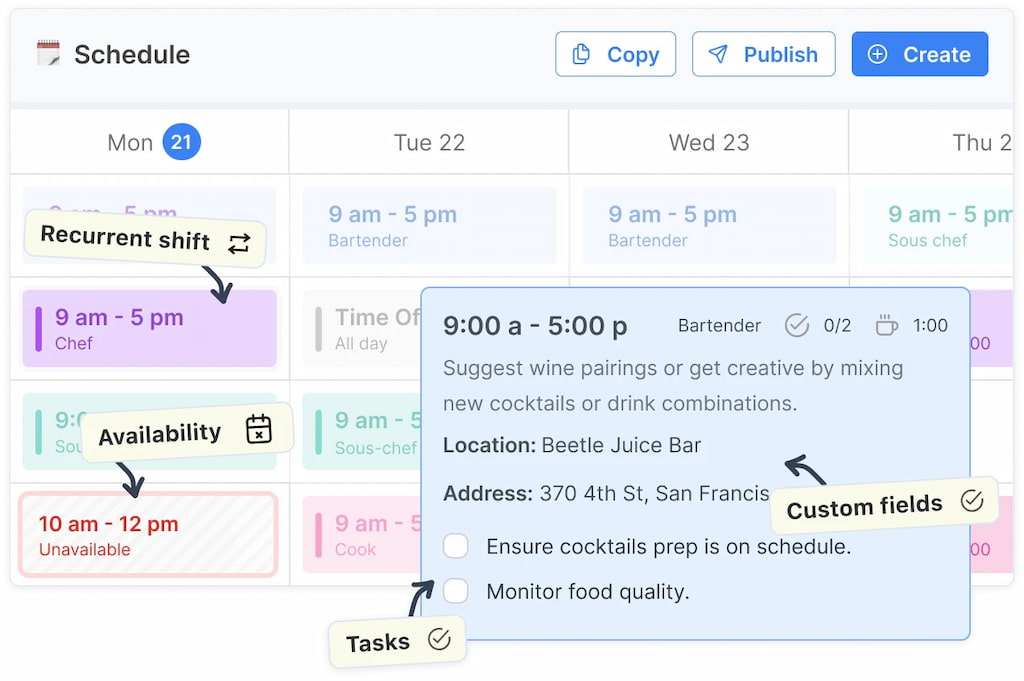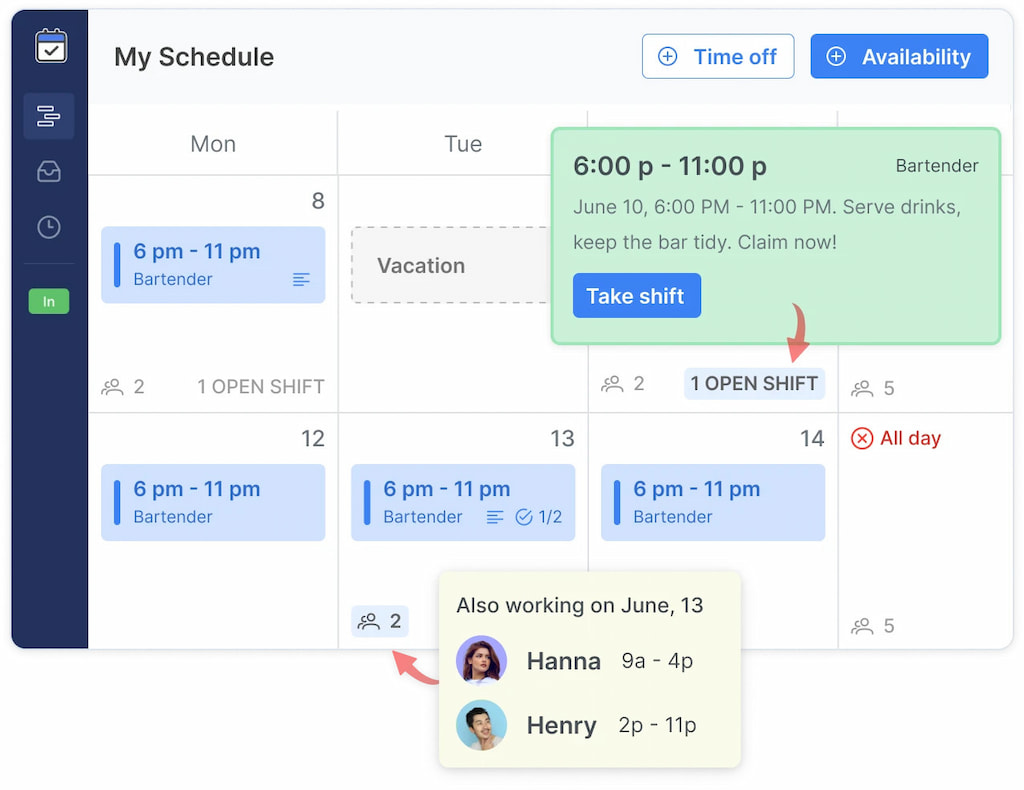Best Staff Scheduling Tools and Software for Efficient Workforce Planning for 2025

It’s Monday morning, and your team’s schedule is still sitting in a spreadsheet. Someone is double-booked, no one is aware of the shift change, and you’re gravitating toward your third cup of coffee wondering how you got here. In 2025, manual scheduling is a risk—not only for chaos in rosters, but for labor cost overruns, unhappy staff, and compliance blind spots. In this article you’ll learn what a staff scheduling system truly meana today, what features matter most, and how tools like Shifts by Everhour and other free employee shift scheduling apps can tie it all together into a smooth operation.
🗓️ What Is a Staff Scheduling System and Why It Matters in 2025
A staff scheduling system is a digital tool that organizes who works when, where, and under what conditions. It handles:
- Shift creation and assignment
- Shift swaps and time-off management
- Availability tracking
- Mobile notifications and alerts
- Integration with payroll and time-tracking
- Analytics and labor-cost forecasting
In 2025, staff scheduling systems are essential for several key reasons:
- 💰 Labor cost pressures — Overstaffing or mis-scheduled shifts directly impact margins.
- 🙋♂️ Employee expectations — Workers demand transparency, mobile access, and flexibility.
- ⚖️ Compliance complexity — Break rules, overtime limits, or union schedules create legal and cost risks.
- 🌍 Hybrid & mobile workforces — Schedules span remote, field, on-site, and variable roles.
- 📊 Data-driven operations — Managers need utilization metrics, coverage insights, and forecasting, not just a roster.
Choosing the right system can turn scheduling from a weekly headache into a strategic advantage.
🛠️ Key Features, Use Cases & What to Focus On
📌 Drag-and-drop schedule builder & mobile publishing
Say goodbye to paper, spreadsheets, and last-minute texts. Modern systems let you:
- Build schedules visually with drag-and-drop tools
- Publish instantly to employee devices
- Handle shift changes and notifications via mobile
🙋♂️ Availability, shift swaps & self-service
Flexibility is essential. Employees can:
- Mark their availability
- Pick up open shifts
- Swap shifts under manager approval

This boosts morale and reduces manager workload.
⚖️ Conflict detection & compliance enforcement
Avoid double-booking, excessive hours, and regulatory violations. Good systems automatically:
- Flag scheduling conflicts
- Enforce labor rules and overtime limits
- Improve coverage reliability
Example: “Online employee scheduling software is increasingly used to flag conflicts, enforce labour law rules, and improve coverage.”
📊 Analytics & labor-cost insights
Scheduling is more than assigning shifts—you need insights. Track:
- Scheduled vs actual hours
- Idle time and overtime
- Shift coverage gaps
- Labor-cost impact
These insights help managers plan smarter, not just create rosters.
🔗 Integration with time tracking, payroll & workforce systems
Integrating scheduling with time-tracking, payroll, and HR systems ensures:
- Elimination of manual errors
- Automatic syncing of scheduled vs actual hours
- Better planning and labor-cost forecasting
For example, linking scheduling tools with trackers ensures your roster directly drives accurate hours and cost data.
🪚 Best Staff Scheduling Systems Compared
| Tool | Key Features | Pricing/Plan | Ideal For |
| Shifts by Everhour | Drag-and-drop scheduling; mobile shift swaps; availability tracking; real-time alerts; time tracking integration | Free & paid plans | Teams needing scheduling and real hours tracking in one place |
| Connecteam | Shift scheduling; geofencing; mobile app; task management; training modules | Free & paid plans | Deskless, mobile or on-site workforces needing scheduling plus communication |
| Deputy | AI-driven scheduling; demand forecasting; time-clock; labor cost analytics; compliance tools | Paid plans | Multi-location businesses and hourly teams needing forecasting power |
| Homebase | Schedule builder; clock-in/out; time-off tracking; payroll integration; free tier | Free & paid plans | Single-location or small SMBs wanting easy scheduling and cost control |
| 7shifts | Restaurant-centric scheduling; tip management; POS integrations; dialog tools; shift trades | Paid plans | Hospitality and restaurant teams with specific operational needs |
| Sling | Simple roster builder; shift reminders; labor cost cues; team messaging | Free & paid plans | Small teams or startups moving off spreadsheets fast |
| When I Work | Shift scheduling; time tracking; team chat; mobile access; auto-schedule | Free trial & paid plans | Teams needing a mobile-first, easy-onboarding scheduling tool |
| ZoomShift | Availability tracking; mobile scheduling; shift offers; labour tracking; simplicity | Paid plans | Small-to-mid-sized teams needing straightforward scheduling |
| TimeTrex | Scheduling + attendance + payroll in one; advanced compliance; all-in-one suite | Paid plans | Teams wanting full workforce management including time & payroll |
| Planday | Multi-department scheduling; time-off approvals; shift swaps; integrations | Paid plans | Growing businesses with complex multiple-team scheduling needs |
Tool summaries
- Shifts by Everhour integrates scheduling and actual time tracking—ideal when you want a unified workflow from roster to worked hours.
- Connecteam stands out when your workforce is mobile, field-based or on-site and you need scheduling along with communication and training.
- Deputy excels when you have multiple locations and need intelligent forecasting and compliance controls.
- Homebase is a strong choice for one-location or small businesses—easy and affordable.
- 7shifts caters to restaurants with built-in hospitality features such as tip tracking and POS integration.
- Sling offers fast setup, simplicity and good value for small teams transitioning off manual scheduling.
- When I Work provides a mobile-first experience with strong shift trading and intuitive interface.
- ZoomShift delivers scheduling focused purely on simplicity and affordability for medium teams.
- TimeTrex brings scheduling, attendance and payroll together—useful when you want all workforce data in one hub.
- Planday handles larger, multi-team organisations requiring department-level scheduling and approvals.
🚀 Why Shifts by Everhour Belongs in Your Workflow
While staff scheduling systems cover the basics, Shifts by Everhour takes it further in 2025 workflows by combining scheduling, visibility, and analytics:
- 🗓️ Visual schedule creation: Build shifts by time, role, and location, then publish instantly to mobile.

- 📱 Team engagement: Employees see upcoming shifts, request swaps, set availability, and get notifications.
- ⏱️ Live time tracking: Hours worked—including breaks and overtime—sync automatically via Everhour.
- 📊 Insightful analytics: Compare planned vs actual hours, detect idle staff, over-covered periods, and inefficiencies.
- ⚡ Proactive workforce management: Scheduling becomes live management with transparency and accountability.

With this approach, you spend less time just building rosters and more time optimizing them. If scheduling still feels reactive or tedious, integrating planning and time-tracking with Shifts is a game-changer.
✅ Best Practices & Actionable Tips for Smart Scheduling
- 📅 Publish early: Share schedules at least one week in advance to reduce last-minute changes and confusion.
- 📝 Collect availability upfront: Ask for employee preferences, restrictions, and time-off early to prevent conflicts.
- ⚡ Use templates: Apply recurring patterns for common shifts to save time and maintain consistency.
- 📱 Enable mobile access: Let employees swap shifts, mark availability, and receive notifications directly on their phones.
- 📊 Track performance: Review weekly metrics to identify idle time, over-staffing, or under-coverage.
- 🔄 Align with demand: Adjust schedules using past data, expected events, and real-time updates.
- ⚙️ Integrate tools: Connect scheduling with time tracking and payroll to avoid manual input errors.
- 🔍 Review and refine: After each cycle, analyze gaps, unapproved swaps, and unbalanced workloads—then optimize for next time.
❓ FAQ: Staff Scheduling Systems
What size team benefits most from scheduling software?
Even a team of 10–20 who work shifts, deal with availability changes or cover weekends will gain value from scheduling tools—as manual scheduling often costs hours, causes errors and frustrates staff.
Can scheduling software integrate with time tracking and payroll?
Yes. Many leading systems include integrations or built-in modules that link scheduled shifts to actual worked hours and payroll. This is increasingly expected in 2025.
What features should I prioritise when choosing a system?
Priorities include ease of scheduling (drag-and-drop), mobile access, shift swapping, availability tracking, conflict detection/compliance, analytics and integrations. Reviews highlight these as key differentiators.
Does scheduling software only work for hourly/shift-based teams?
While shift-based teams benefit most, any role with varying assignments, flexible hours or multiple locations can gain from scheduling systems—especially when they integrate time tracking or resource assignment.
How long does implementation usually take?
For small teams it can be done in days; for larger or more complex organisations involving multiple sites and integrations, setup may take several weeks. Start with basic scheduling then layer integrations.
🔎 Final Thoughts: Staff Scheduling System
The best staff scheduling systems do more than assign shifts—they bring clarity, fairness, cost-control and flexibility to scheduling. In 2025, your scheduling choice impacts not just planning, but employee experience, labour cost and operational efficiency.
When evaluating your options, focus on: scheduling ease, mobile/availability, conflict detection, analytics, and integration with time tracking or payroll. If your staff scheduling still feels disjointed or manual, consider how Shifts by Everhourintegrates shift planning and live tracking into a single workflow—making scheduling less of a burden and more of a strategic asset.
